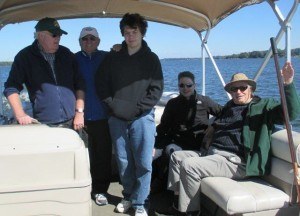Understanding Lake Scugog 2015

Lake Scugog is a story of change because of varying lake levels, advancing and receding water clarity, climate change, aquatic plant and algae variations. While monitoring the lake in 2015 the Scugog Lake Stewards noticed remarkable changes, from a water system recently heavily infested by the invasive aquatic plant hybrid Eurasian watermilfoil (EWM), to a seemingly pristine environment which was a delight for boaters and anglers alike. The EWM has been replaced by a mixture of two algae, Chara and Nitellopsis obtusa or Starry Stonewort(SS). It filled parts of the lake bottom with meadows of green growth often to a few feet or less of the surface while displacing stands of most native aquatic plants.

What these changes mean for the lake in future years was the subject of a roundtable discussion hosted by the Lake Stewards, in Port Perry, in early October. Participants from Trent University, UOIT, the Ministry of Natural Resources and Forestry and Kawartha Conservation took part.
Dr Sager of Trent U. discussed the collapse of EWM this year and noted that collapse and full recovery, for no apparent reason, have been recorded periodically since 1970. The invasive aquatic hybrid EWM from a cross between exotic Eurasian watermilfoil and native Northern milfoil may have been in the lake for many years only to assume dominance again in the immediate past. Dr. Sager believes that Starry Stonewort is an opportunistic invader coming as the EWM collapsed. He discussed recent experience with Starry stonewort, as seen at left, in Michigan and Wisconsin lakes. It suggests it may be difficult to contain this alga. Dr Sager also suggests we may see blooms of blue/green algae in the future as they are associated with the heavy rains resulting from global climate change.
Brett Tregunno from Kawartha Conservation discussed the new water clarity which has been so apparent in Lake Scugog this year. There is no single explanation for this and it is not the presence of SS alone which is the sole factor. Starry stonewort, zebra mussels, higher water levels, high calcium levels producing Marl, or other factors, may be involved.
Marty McGrath and Lisa Solomon of the MNRF discussed their involvement in lake Scugog and its fishery since 1980. High angler pressure and the fall-off of Walleye stocks in recent years dictate this interest. They have extensive knowledge of the Walleye population decline and have mapped the Walleye spawning grounds as part of plans to rehabilitate the Walleye population. A ‘Walleye Watch’ along the Trent-Severn Waterway is being organized with volunteers for the spring of 2016 to begin observations of their spawning numbers. The stewards have been invited to be involved in this work.
Proposed research studies, involving the stewards and our colleagues, were outlined by Dr Kirkwood of U.O.I.T. and early detailed plans of what can be done together for the betterment of the lake were discussed. These collaborative studies will begin in summer 2016 and are heavily dependant on the success of funding initiatives and voluntary contributions from you all.
The Scugog Lake Stewards are deeply grateful to John Mackey of Port Perry Marina for the loan of a pontoon boat once a month for 6 months. We are also grateful to Scugog Township for allowing the Stewards to hold the above Roundtable Discussion in Council Chambers in the Township office. Our activities could not happen without a wide range of excellent partners.
